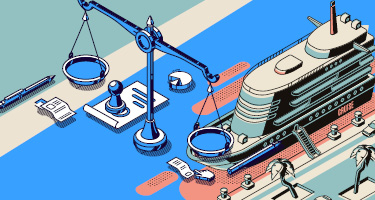Since Congress never defined the term “seaman,” the definition of and distinction between employees entitled to benefits under the Longshore and Harbor Worker’s Compensation Act (“LHWCA”) as opposed to the Jones Act, has been the subject of extensive litigation and courts have struggled to establish workable tests to define the word “seaman.”
In a recent en banc opinion in Gilbert Sanchez v. Smart Fabricators of Texas, LLC, the United States Fifth Circuit Court of Appeals further clarified the necessary criteria required for a land-based worker to qualify as a Jones Act seaman. In doing so, the court questioned and limited two prior Fifth Circuit decisions which had improperly expanded the scope of seaman status.
PREVIOUS COURT RULINGS ON SEAMAN’S STATUS UNDER THE JONES ACT
Dating back to McDermott Int’l, Inc. v. Wilander, in 1991, the United States Supreme Court (“SCOTUS”) has addressed an employee’s entitlement to seaman status under the Jones Act several times. Following Wilander, SCOTUS addressed seaman status again in 1995 in Chandris, Inc. v. Latsis, and again in 1997 in Harbor Tug and Barge Co. v. Papai.
Wilander – Key to Seaman Status is Employment-Related Connection to Vessel in Navigation
In Wilander, SCOTUS took that case primarily to resolve a split among the circuits on the question of whether plaintiff, to establish seaman status, was required to show that he aided in the navigation of a vessel. The court rejected the circuit cases imposing that requirement and adopted a test requiring proof that the seaman “contributed to the function of the vessel or to the accomplishment of its mission” and have an employment-related connection to a vessel. In Wilander, the court held that “the key to seaman status is employment-related connection to a vessel in navigation.”
Chandris – Substantial-Connection Test is Two Elements
In Chandris, the court took up the question of whether a supervising engineer who oversaw an engineering department for a fleet of six passenger cruise ships was a seaman. He had developed a detached retina while sailing on one of the vessels and filed suit because of an alleged delay by his employer in providing medical care. In that case, the court was asked to define the “relationship a worker must have to the vessel, regardless of the specific task that the worker undertakes in order to obtain seaman status.”
The Chandris court recognized that with the passage of the LHWCA, Congress established a clear distinction between land-based and sea-based maritime workers. Only the latter who owe their allegiance to a vessel and not solely to a land-based employer were seamen.
The Chandris court emphasized the importance of the requirement that a seaman have a substantial, enduring relationship to a vessel and that a worker could not oscillate back and forth between Jones Act coverage and other remedies depending on the activity in which the worker was engaged while injured.
As such, in Chandris, the court defined the substantial-connection test as being two elements: “A seaman must have a connection to a vessel in navigation (or to an identifiable group of such vessels) that is substantial in terms of both its duration and its nature.” In discussing the duration element, the court held that the total circumstances of an individual’s employment must be weighed.
In that case, since the amount of time the plaintiff spent working on his employer’s vessels as opposed to his land-based work was unclear, the court remanded the case so that the appropriate principles could be applied to the facts.
Papai – Employee’s Duties Must Take Him to Sea
In Papai, the ship owner, Harbor Tug, was one of several tug boat operators operating in San Francisco Bay that obtained workers through a union hiring hall. Papai was engaged through the union hall to paint the housing on a harbor tug and the entire time that he performed his work, the tug was located dockside.
The Papai court stated that “for the substantial connection requirement to serve its purpose, the inquiry into the nature of the employee’s connection to the vessel must concentrate on whether the employee’s duties take him to sea.” Since Papai’s actual duties on that tug did not include any seagoing activity, and the fact that his relationship to the entire group of vessels that he worked on was transitory and sporadic, the court found that he was not a seaman.
GILBERT SANCHEZ V. SMART FABRICATORS OF TEXAS, LLC – BACKGROUND
Sanchez dealt with a land-based welder employed by Smart Fabricators of Texas, LLC (“SmartFab”). It was a contract welding firm engaged in steel fabrication, repairs to drilling equipment, and general contract welding work. Its welders worked to meet the demands of its customers on land and sometimes on jack-up drilling barges.
Sanchez worked for SmartFab for a total of 67 days between August 2017 and August 2018. Six of those days were spent working on welding jobs either on land or vessels that were irrelevant to his seaman status claim because they were not owned or controlled by Enterprise. Sanchez claimed that he was a seaman because of work that he performed on two jack-up barges owned by SmartFab’s customer, Enterprise Offshore Drilling LLC (“Enterprise”).
Sanchez spent the remaining 61 days on two different jack-up drilling rigs owned by Enterprise. He spent 48 days performing welding work on a discrete repair job, while the rig was jacked-up next to a dock in Sabine Pass, Texas. He commuted from his home to the vessel daily.
Sanchez also worked 13 days on another jack-up rig while it was located on the Outer Continental Shelf. He fell on that second rig while he was offshore.
DISTRICT COURT RULING IN SANCHEZ – NOT A JONES ACT SEAMAN
Sanchez sued SmartFab in state court under the Jones Act. SmartFab timely removed the case but Sanchez filed a Motion to Remand, arguing that the Jones Act precluded removal. SmartFab also filed a Motion for Summary Judgment, seeking a dismissal of Sanchez’s claims on the grounds that he was not a Jones Act seaman.
The district court denied Sanchez’s Motion to Remand and granted SmartFab’s Motion for Summary Judgment, both for the same reason – Sanchez was not a seaman. In reaching that conclusion, the court concluded that Sanchez failed to establish a substantial connection in terms of the nature of his work to the Enterprise fleet of jack-up barges.
FIFTH CIRCUIT RULING IN SANCHEZ: LAND-BASED WORKERS AREN’T SEAMAN
On appeal, the Fifth Circuit initially reversed and held that Sanchez satisfied the requirements for seaman status based upon two earlier Fifth Circuit decisions: In Re Endeavor Marine, Inc., 234 F.3d 287 (5th Cir. 2000) and Naquin v. Elevating Boats, LLC, 744 F.3d 927 (5th Cir. 2014). However, one member of the appeal panel filed a concurring opinion, joined by other members of the panel, questioning whether that Fifth Circuit precedent was in line with SCOTUS case law and proposed that the Fifth Circuit consider the question en banc. Thereafter, the court en banc reversed the original appeal panel and affirmed the judgment of the district court, dismissing Sanchez’s claims that he was a seaman.
This decision was authored by Honorable W. Eugene Davis, Circuit Judge, who was clear in stating that the court wanted to distinguish seaman entitled to benefits under the Jones Act from other maritime workers generally covered under the LHWCA. The court ruled that Sanchez was not engaged in sea-based work that satisfied the requirement that he be substantially connected to a fleet of vessels in terms of the nature of his work.
Importantly, in addressing the nature of the work requirement, the Fifth Circuit held that the following additional inquiries had to be made: (1) does the worker owe his allegiance to the vessel, rather than simply to a shore side employer?; (2) Is the work sea-based or involved sea going activity?; and (3)(a) Is the worker’s assignment to a vessel limited to the performance of a discreet task after which the worker’s connection to the vessel ends, or (b) Does the worker’s assignment include sailing with the vessel from port to port or location to location?
The court held that Sanchez did not meet any of those criteria and that simply asking whether a worker was subject to the “perils of the sea” was not enough to resolve the nature element.
The impetus of Sanchez is that land-based workers, who only have a transitory or sporadic connection to a vessel or group of vessels, are not seamen.



















